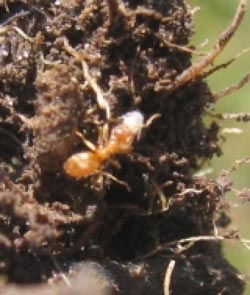Ants farm root aphid clones in subterranean rooms

The yellow meadow ant, Lasius flavus, farms root aphids for sugar (honeydew) and nitrogen (protein). Credit: Aniek Ivens<br>
In turn these species of aphids have developed distinctive traits never found in free living species such as the 'trophobiotic organ' to hold honey dew for the ants. New research published in BioMed Central's open access journal BMC Evolutionary Biology shows that over half of ant mounds contained only one of the three most common species of aphid, and two thirds of these has a single aphid clone. Even in mounds which contained more than one species of aphid 95% of the aphid chambers contained individuals of a single clone.
Aphid farming by ants is considered to be mutualistic. The ants cultivate and protect the aphids which in turn provide food for the ants. In farming mutualism, monocultures may reduce competition and are perhaps the result of husbandry (caused by the ants selecting the best aphids for their needs).
Researchers from the University of Copenhagen, University of Groningen and Rockefeller University used DNA microsatellite analysis to look at the genetic similarity of the three most common species of root aphids (Geoica utricularia, Tetraneura ulmi, and Forda marginata) within L. flavus nests, soil samples within nests, and single aphid chambers.
Results indicated that while there was considerable aphid diversity within the 7 km test site at all sampling levels (ant mound, soil sample and chamber), monocultures occurred more frequently than expected. 52% of mounds and 99% of aphid chambers contained a single species and 60% of these contained a single clone. When multiple species or clones existed in the same mound they were kept separated.
Aniek Ivens, who led this research, explained, “Although two years later most ant mounds seemed to contain the same clones, two mounds had gained new clones of their species. It is possible that either these aphids have been brought in or that they were previously at a very low level in the mound and missed during an earlier survey.”
The combination of underground nesting, aphid clones, and very low gene flow between aphid populations has allowed L. flavus to evolve an unusual form of symbiosis. Miss Ivens continued, “In a parallel with human farming methods this most likely gives colonies the possibility to actively manage the diversity and abundance of their livestock – allowing maximal honeydew yield from mature aphids that are kept under optimal conditions of phloem feeding and ant care. Ants also secure dietary protein by eating the excess of young aphids, and replacement of their honeydew-producing livestock when adult aphids become less productive.”
1. Ants farm subterranean aphids mostly in clone groups: an example of prudent husbandry for carbohydrates and proteins?
Aniek BF Ivens, Daniel JC Kronauer, Ido Pen, Franz J Weissing and Jacobus J Boomsma
BMC Evolutionary Biology (in press)
Please name the journal in any story you write. If you are writing for the web, please link to the article. All articles are available free of charge, according to BioMed Central's open access policy.
Article citation and URL available on request at press@biomedcentral.com on the day of publication.
2. BMC Evolutionary Biology is an open access, peer-reviewed journal that considers articles on all aspects of molecular and non-molecular evolution of all organisms, as well as phylogenetics and palaeontology.
3. BioMed Central is an STM (Science, Technology and Medicine) publisher which has pioneered the open access publishing model. All peer-reviewed research articles published by BioMed Central are made immediately and freely accessible online, and are licensed to allow redistribution and reuse. BioMed Central is part of Springer Science+Business Media, a leading global publisher in the STM sector.
Media Contact
More Information:
http://www.biomedcentral.comAll latest news from the category: Life Sciences and Chemistry
Articles and reports from the Life Sciences and chemistry area deal with applied and basic research into modern biology, chemistry and human medicine.
Valuable information can be found on a range of life sciences fields including bacteriology, biochemistry, bionics, bioinformatics, biophysics, biotechnology, genetics, geobotany, human biology, marine biology, microbiology, molecular biology, cellular biology, zoology, bioinorganic chemistry, microchemistry and environmental chemistry.
Newest articles

“Nanostitches” enable lighter and tougher composite materials
In research that may lead to next-generation airplanes and spacecraft, MIT engineers used carbon nanotubes to prevent cracking in multilayered composites. To save on fuel and reduce aircraft emissions, engineers…

Trash to treasure
Researchers turn metal waste into catalyst for hydrogen. Scientists have found a way to transform metal waste into a highly efficient catalyst to make hydrogen from water, a discovery that…

Real-time detection of infectious disease viruses
… by searching for molecular fingerprinting. A research team consisting of Professor Kyoung-Duck Park and Taeyoung Moon and Huitae Joo, PhD candidates, from the Department of Physics at Pohang University…





















